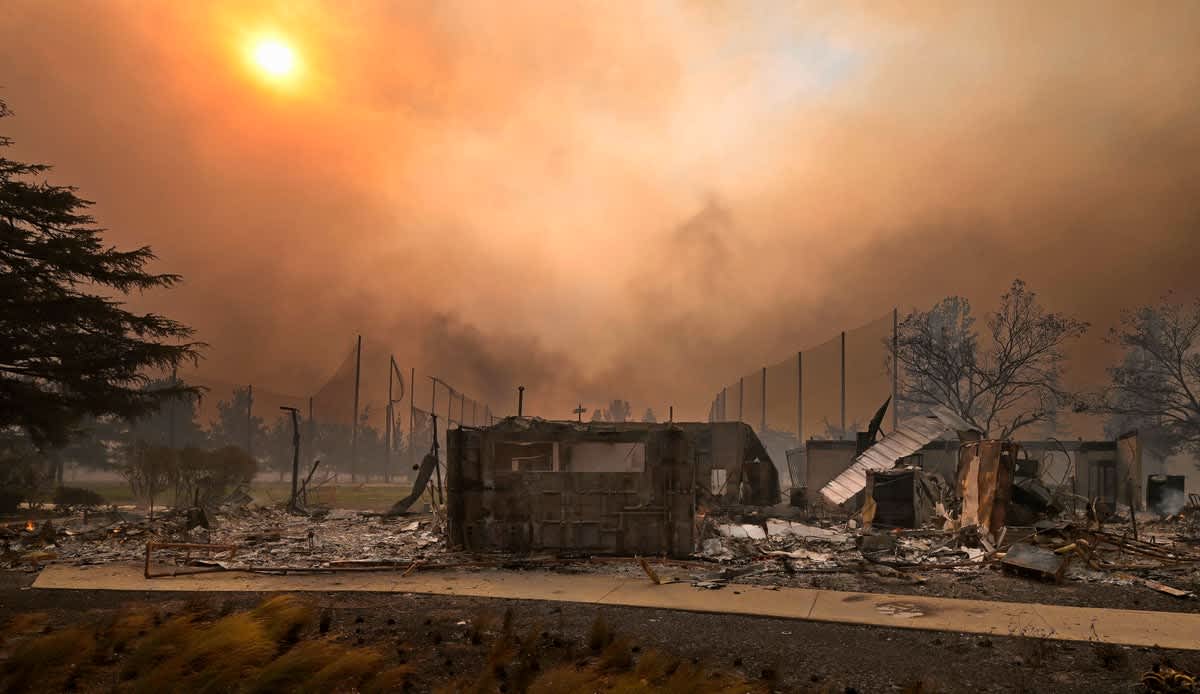Here’s How Climate Change Fueled the Los Angeles Wildfires
Many factors, such as strong Santa Ana winds and urban planning decisions, played into the recent destructive wildfires in the Los Angeles area. But the evidence is clear that climate change contributed
Smoke shrouds the sun as it rises above the Altadena Town and Country Club which was destroyed by the Eaton fire in Altadena.
The horrific wildfires that ripped through parts of the Los Angeles area last week were, like many disasters of this scale, the result of a perfect storm of circumstances. Unusually strong Santa Ana winds topped off decades of decisions about land management and urban planning—setting a stage for sparks (with a still unknown origin) that ignited some of the most destructive infernos in California’s admittedly fire-prone history.
But contrary to the assertions of some politicians (notably President-elect Donald Trump and his nominee for Department of Energy chief, fracking company executive Chris Wright), the scientific evidence is clear that climate change helped fuel the ferocity of these blazes. Hotter, drier conditions and increasing “weather whiplash” made the local vegetation much more flammable.
If you’re enjoying this article, consider supporting our award-winning journalism by subscribing. By purchasing a subscription you are helping to ensure the future of impactful stories about the discoveries and ideas shaping our world today.
Unlike forest fires in other parts of the state, blazes in coastal southern California burn in grass and brush. This is an important distinction because year-to-year variations in the precipitation that falls during the winter wet season don’t substantially change the abundance of plants in forests. But in areas like those hit by the latest Los Angeles fires, more winter rains mean a lot more grass and brush growth come spring.
When the summer dry season begins, all of that grass and brush dries up. And as global and local temperatures rise with the accumulation of greenhouse gases in the atmosphere, the atmosphere itself becomes “thirstier”—so it sucks up even more moisture from the ground and vegetation through evaporation. The drier the fuel, the more readily and fiercely it will burn when any spark arises.
An analysis by University of California, Los Angeles, climate scientists found that vegetation in the area where Palisades and Eaton Fires ignited was 25 percent drier than it would have been in the absences of climate change. “We believe that the fires would still have been extreme without the climate change components noted above, but would have been somewhat smaller and less intense,” said the analysis’s authors in a press release from U.C.L.A. A separate analysis by the ClimaMeter, a group of climate scientists working to provide rapid assessments of weather extremes using climate models, also found that climate change had amplified the dry conditions—with temperatures up to five degrees Celsius (nine degrees Fahrenheit) hotter and conditions up to 15 percent drier in the past few decades than in the period from 1950 to 1986.
But climate change doesn’t just make things worse by drying out the brush. It also contributes to what Swain and some of his colleagues call a “whiplash” between very wet and very dry conditions. Southern California is seeing more instances of very wet winters followed by hot, dry summers and autumns. And that is exactly what happened prior to the recent fires: the winters of 2022 –2023 and 2023 –2024 were unusually damp, causing more vegetation to spring up across the landscape. And then the summer and autumn of 2024 were extremely hot and dry—in fact, this was the driest start to winter on record, Swain remarked last week during one of his one of his regular “virtual climate and weather office hours,” hosted on YouTube.
Another factor that adds to the risks is the fact that the dry season is stretching out, beginning earlier in the spring and lasting longer into autumn. And the longer it extends into fall, the more overlap there is with the Santa Ana wind season, which runs from October through January. Usually rain would have fallen before January, quenching the thirsty plants and tamping down the fire risk. But this year there has been negligible rain as late fall has turned into winter.
The notorious Santa Ana winds are a substantial driver of fire risk in southern California. They can reach hurricane force (gusts clocked as high as 99 miles per hour last week), spreading fires so quickly that they become impossible to contain. Whipping winds carry embers out for a mile or more ahead of the fire front, igniting spot fires. The winds also make it unsafe for firefighters to fly water-dumping planes and helicopters over the fires.
Although the factors that lead to these disasters are complex, it is clear that climate change is creating conditions that are ripe for wildfires. As Greta Cazzaniga, a climate scientist at the ClimaMeter and the Pierre-Simon Laplace Institute in France, said in a recent press statement, “the Los Angeles wildfires have shown how multiple extremes, exacerbated by climate change, can interact together to trigger an unprecedented disaster.”
Andrea Thompson is an associate editor covering the environment, energy and earth sciences. She has been covering these issues for 16 years. Prior to joining Scientific American, she was a senior writer covering climate science at Climate Central and a reporter and editor at Live Science, where she primarily covered earth science and the environment. She has moderated panels, including as part of the United Nations Sustainable Development Media Zone, and appeared in radio and television interviews on major networks. She holds a graduate degree in science, health and environmental reporting from New York University, as well as a B.S. and an M.S. in atmospheric chemistry from the Georgia Institute of Technology. Follow Thompson on Bluesky @andreatweather.bsky.social
Source: www.scientificamerican.com
